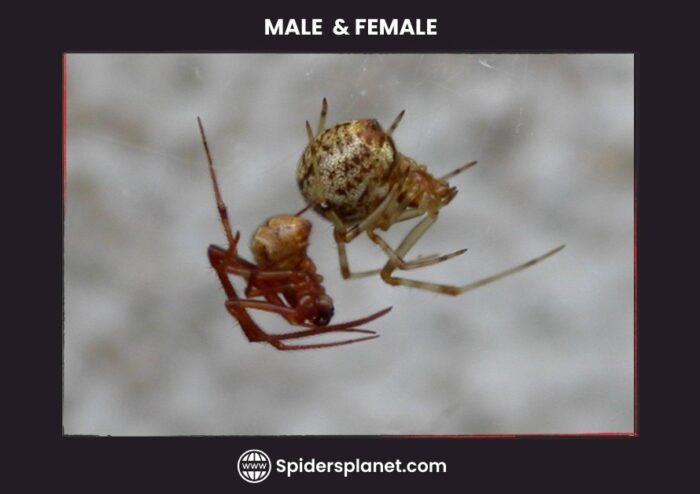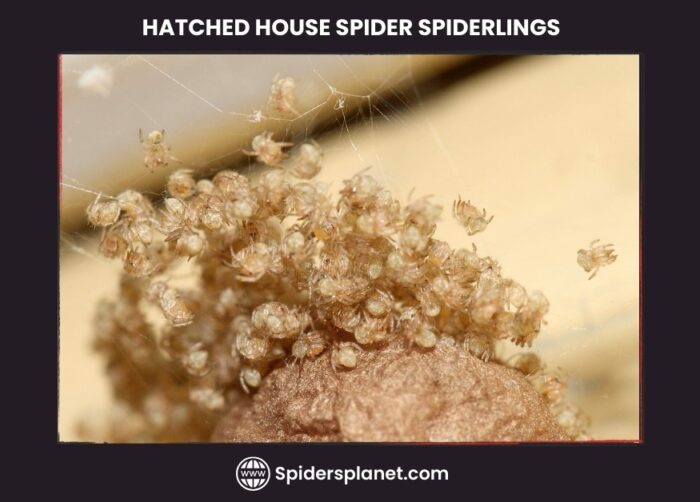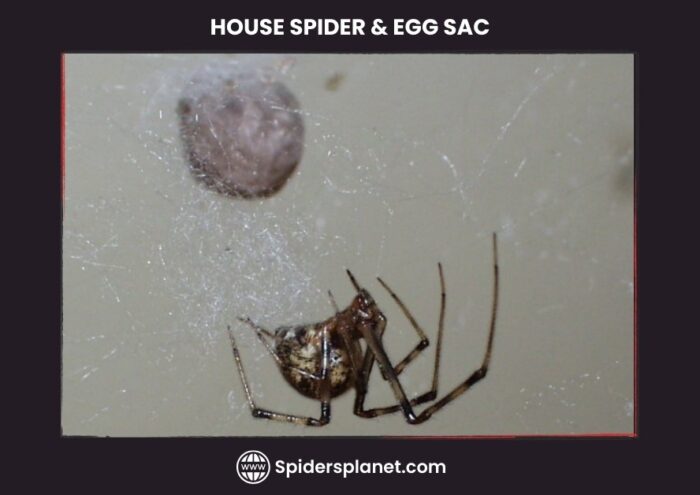Curious about those house spiders lurking behind your bookshelf or in the corners? Despite giving some people chills, these eight-legged creatures are actually quite fascinating!
Beyond their intricate webs and swift movements, there is a hidden world of hunger with a unique menu.
Skip the bug spray, as today, we are exploring the surprisingly helpful diet of house spiders.
These spiders serve as a natural pest control team in your home, mainly feasting on common household insects.
Despite common fears, they rarely bite humans, and their unintentional presence is often fueled by an abundance of their preferred prey.
Understanding their diet and removing attractants is key to a spider-free home.
Discover the unexpected meals that fuel these clever hunters, and you may see them as tiny heroes maintaining a pest-free environment.
Ready for a journey into the world of what house spiders eat? Keep reading!
Common House Spider Description:
Scientific Name and Family:
The common House spider or American house spider, scientifically known as Parasteatoda tepidariorum, The term “Parasteatoda” denotes the spider’s genus.
In contrast, the Latin word “tepidariorum” is associated with a warm environment. The spider falls under the Animalia kingdom, Arachnida class, and Theridiidae family.
Species and Types:
The term “house spider” is a general label encompassing 11 distinct spider species frequently encountered in and around human habitats, each identified by its common name:
- Black house spider– Badumna Insignis
- Brown house spider– Steatoda grossa
- Common cellar spider– Pholcus phalangioides
- Domestic house spider– Tegenaria domestica
- Giant house spider– Eratigena atrica
- Hobo spider– Eratigena agrestis
- Geometric house spider– Latrodectus geometricus
- Tiny house spider– Oonops domesticush
- Yellow sac spider– Chiracanthium inclusum
- Southern house spider– Kukulcania hibernalis

Appearance:
Size and Color:
Common house spiders have a spectrum of colors, ranging from tan to nearly black, often adorned with diverse patterns on their bodies.
Female spiders typically measure between 5 and 6 millimeters (0.20 and 0.24 inches) in length, while their male counterparts are generally smaller, ranging from 3.8 to 4.7 millimeters (0.15 and 0.19 inches).
With legs extended, they can exceed an inch (2.5 cm) in width.
Body Anatomy:
Their body consists of a cephalothorax, housing the head and thorax with a tough exoskeleton; chelicerae, fang-like mouthparts for injecting venom; pedipalps, aiding in feeding and mating; eight simple eyes providing broad vision.
A soft, bulbous abdomen containing internal organs and spinnerets for silk production; and eight long, hairy legs equipped with three claws each for movement, web construction, and prey capture.
Understanding these features unveils the common house spider’s impressive skills as both hunter and survivor in our homes.
Habitat:
The common house spider has a diverse habitat, thriving both outdoors and indoors. In outdoor settings like gardens and forests, they spin webs to catch bugs and enjoy fresh air.
When temperatures drop, they seek warmth in sheds and barns. Indoors, these adaptable spiders favor basements and quiet corners as their hunting grounds.
They can make homes in unexpected places, like behind bookshelves or in attics, as long as there’s consistent food and minimal disturbance.
The spider’s web, whether outdoors or indoors, serves as their primary location for hunting and creating intricate structures that aid in their survival.
The common house spider effectively navigates between outdoor adventures and indoor settings, highlighting the versatility of these small creatures in the broader context of the natural world.
Behavior:
Male and female American house spiders often share the same web for extended periods, and multiple females might build their webs close to one another.
However, occasional fights can occur between females when they cross paths.
In terms of their engagement with humans and possible threats, these spiders generally display non-aggressive behavior.
They usually tolerate a human hand approaching their web, but if you try to grab or squeeze them, they might bite in self-defense.
Although they prefer to avoid biting, their close proximity to humans increases the likelihood of such encounters.
Common house spiders have limited vision and can only detect movement within a range of three to four inches. If they feel trapped, their last resort is to pretend to be dead.
What do Parasteatoda tepidariorum Eat?
House spiders, the eight-legged inhabitants often found in corners and windows, are predominantly carnivorous and have a diverse menu of insect delights.
Common house spiders typically consume small insects and household pests like flies, mosquitoes, ants, and wasps, effectively acting as miniature pest control units to curb unwanted house guests.
Depending on their size, they may also target larger prey such as grasshoppers, butterflies, cockroaches, silverfish, or other spiders.
When dealing with agile prey, the spider may shoot webs at it from a distance and then pull the thread toward itself.
Larger female spiders can even attract baby skinks into their webs by leaving remains of flies hanging in them.
After the prey is consumed and its remnants dry out, the spider often drops them to the floor. This behavior is a method to free up space in the web rather than rebuilding or relocating it.
Depending on their size and species, common Parasteatoda tepidariorum might also eat tinier bugs like gnats and midges.
If they come across another spider, they might even eat it if the chance comes up. Even though their webs can catch things that are not bugs, like other spiders, they won’t ignore an easy meal if they find one.
However, they avoid fruits, fish, frogs, mice, plants, slugs, and snails. House spiders usually prefer freshly deceased insects and avoid larger prey like mice or frogs.
Rest assured, humans are definitely not on their menu! While some spider species may resort to cannibalism in extreme situations, most house spiders peacefully share their webs and spaces without dining on each other.
How do Parasteatoda tepidariorum Eat or Hunt?
Common House spiders engage in a fascinating eating ritual. They either make sticky webs or actively chase after their food with vibrating silk strands alerting them to potential meals.
When they catch something, the spider injects venom through hollow fangs, paralyzing the prey and transforming its insides into a liquid for easier consumption.
Larger prey may be wrapped in silk for future consumption. Remarkably, house spiders cannot chew solid food, relying on digestive enzymes in their venom to break down liquefied prey.
With straw-like mouthparts, they then suck up the nutritious liquid, leaving behind an empty exoskeleton.
Post meal, the spider may tidy its web and discard digested remains, keeping its hunting ground fresh.
Some species even recycle silk from exoskeletons for future web construction, showcasing both resourcefulness and efficiency in their dining process.
How Often Do Parasteatoda tepidariorum Eat?
House spiders exhibit remarkable flexibility in their eating habits, adapting to the availability of food and their metabolic needs.
When prey is abundant, these spiders can be voracious eaters, feasting up to four times a day by capturing items in their webs.
In times of scarcity, they enter a low-power mode, surviving for weeks without a meal as their metabolism slows down, conserving energy.
Hunger levels are influenced by factors such as the spider’s size, species, temperature, and molting phase.
Larger spiders generally require more food, warmer temperatures increase their activity and metabolism, and during molting, they focus on energy conservation and typically abstain from eating.
House spiders, therefore, showcase a capacity to adjust their eating habits based on varying circumstances, highlighting their surprising resilience.
A useful tip for understanding a specific spider’s feeding habits is to observe its web placement and activity level.
A bustling web with frequent prey capture indicates a well-fed spider, while a neglected web may suggest a longer fasting period.
Can They Survive Without Eating?
House spiders hunt actively or use their webs to trap prey, and they can survive for extended periods without food, relying on touch and taste receptors to discern edible items.
Importantly, humans are far too large for house spiders to consider as prey, so you can rest assured that you are not on their menu.
How Long Can House Spiders Survive Without Eating?
House spiders are surprisingly tough when it comes to going without food, and the time they can survive depends on a few things.
Normally, most house spiders can manage without food for 2-4 weeks, and some bigger ones might even make it to 6-8 weeks.
In extreme cases, with little activity and good conditions, reports suggest they could survive for several months without eating.
The size of the spider and its species play a role, with bigger spiders and different types lasting longer.
Warmer temperatures make them need more food, while cold ones slow them down, letting them go longer without eating.
Having water is important, too, and if there is not much food around, spiders can go into a low power mode to save energy.
Spiders have strategies for surviving without food, like having a slow metabolism, being less active when hungry, and even recycling nutrients from past meals or their own old skin.
Also Read: How Many Eyes Do Wolf Spiders Have?
What do Baby House Spiders Eat?
Baby house spiders, or spiderlings, start with a yolk sac for their initial nutrients and then venture into a world of tiny treats like dust mites and pollen grains.
As they grow, they upgrade to larger prey, such as midges and tiny ants. Some spiderlings share meals in a communal setting, while others are independent hunters.

Even though they are small in size, these spiders can endure prolonged periods without eating while undergoing the molting process.
Occasionally, cannibalism may occur when food is scarce among spiderlings. Their webs, less structured than adult webs, mirror their size and prey preferences.
Reproduction, Babies, and Lifecycle:
The common house spider, or Parasteatoda tepidariorum, goes through a fascinating reproductive cycle.
Mating occurs in the fall, with males transferring sperm to the female’s specialized organ. After mating, the female lays eggs in a silken sac, producing multiple sacs throughout her life.
Each egg sac of the common house spider (Parasteatoda tepidariorum) is a bustling nursery, housing an impressive 150–200 eggs.

Throughout its lifetime, a single female spider can produce a remarkable 15–20 of these egg sacs.
The eggs hatch in about a week, giving birth to tiny, soft-bodied spiderlings that molt and grow.
Spiderlings go through several molts, with males typically having six instars and females seven.
After reaching maturity, spiderlings become adults and continue growing for a few more months before reproducing.
Adult house spiders, living up to a year, are solitary and spin webs to catch prey for survival.
They face various predators, including other spiders, birds, and insects, utilizing their webs as a defense mechanism.
How long do House Spiders Live?
The lifespan of the common house spider, Parasteatoda tepidariorum, varies based on gender:
Females: Generally live for approximately 2-3 years, with some individuals reaching up to 5 years in optimal conditions.
Males: Experience a notably shorter lifespan, surviving for only about 6-12 months after reaching maturity. This difference in lifespan between males and females is a common trait in the spider world, reflecting the distinct roles each gender plays in the species’ life cycle.
Do House Spiders Make Webs?
House spiders are renowned for their intricate web-making skills.
They typically construct two main types of webs: cobwebs, messy and tangled, perfect for trapping flying insects, and sheet webs, flatter structures with a funnel retreat to capture crawling insects.
Building a web can take from minutes to hours, showcasing the spider’s efficiency.
These webs are vital for survival, providing a passive trapping system for food, conserving energy, and offering protection from predators.
So, the seemingly dusty cobwebs in your home are, in fact, masterpieces of engineering created by skilled hunters, the humble house spiders.
Predators:
Parasteatoda tepidariorum have to watch out for bigger spiders, centipedes, and insects that might eat them. Birds like sparrows and wrens, lizards, and even small mammals such as mice can also be a threat to these eight-legged creatures.
Bite and Venom:
House spiders are generally harmless to humans. They rarely bite, and if they do, the effects are usually mild, like a little redness or swelling.
While their venom is potent against insects they prey upon, it lacks the strength to inflict significant harm on humans.
So, there is no need to worry about these eight-legged neighbors in your home – they are more helpful than harmful!
Some Common Spiders Find in Homes:
- Wolf spiders
- Brown recluse spider
- Cellar spiders
- Jumping spiders
- Orb-weaver spiders
- Widow spiders
- Hobo spider
- Black house spider
- Grass spiders
- Tegenaria domestica
- Yellow Sac Spider
- Giant house spider
- Sac spiders
- Zebra Jumping Spider
- Pholcus phalangioides
- Southern house spider
- Furrow spider
- Tan jumping spider
- Black-footed yellow sac spider
- Brown widow
- Araneus gemmoides
- Agelenidae
- Red-backed jumping spider
- Cardinal spider
Also Read: Do Spider Mites Kill Plants?
Concluding Facts About House Spiders:
- House spiders are generally not aggressive toward humans and seldom bite unless provoked.
- Their weak venom poses little danger to humans, causing only mild reactions in rare cases.
- Not all house spiders are cobweb spiders. While many construct messy cobwebs, some species choose different web types or actively hunt for prey. This means not every indoor spider is necessarily a common house spider.
- They spin irregular, tangled webs, commonly called cobwebs, in corners, basements, and other undisturbed areas.
- Sadly, male house spiders have a lifespan of only 6-12 months after reaching maturity. Females, on the other hand, can live for 2-3 years.
- Females lay their eggs in silken sacs, each containing up to 400 spiderlings! These sacs are often hidden in protected corners of their webs.
- Unlike many spiders, they don’t actively chase prey. Instead, they patiently wait in their webs, sensing vibrations when an insect gets snagged.
- They are not aggressive towards humans and will usually bite only if they feel threatened.
- They are beneficial insects, as they help to control populations of other pests, such as flies and mosquitoes.
- After a meal, they recycle their webs, absorbing the nutrients from captured insects before rebuilding them in the same spot.
- They are found all over the world, including in homes and buildings.
FAQs:
What do giant house spiders eat?
These large hunters tackle bigger prey like roaches, crickets, and even small lizards.
What do small house spiders eat?
Tiny spiders stick to smaller meals like ants, gnats, and dust mites.
What do black house spiders eat?
Generally eat similar insects to other Parasteatoda tepidariorum, like flies, moths, and mosquitoes.
What do house spiders eat in winter?
In colder months, Parasteatoda tepidariorum less due to reduced insect activity. They might scavenge for leftover bits or even go weeks without food.
Do house spiders eat bed bugs?
While not their first choice, Parasteatoda tepidariorum might eat them if they encounter them.
Do house spiders eat fleas?
Some spiders might catch and eat fleas, but they are not a primary target.
What do spiders eat in a clean house?
Even in clean houses, spiders can find tiny insects like dust mites or spiders that wander indoors.
What do brown house spiders eat?
These web weavers feast on flies, gnats, and other small crawling insects.
Some Bonus Questions and Answers
What do grey house spiders eat?
Their menu consists of insects like ants, gnats, and small flies.
What do house-jumping spiders eat?
These active hunters eat bugs like flies, ants, and even other spiders smaller than them.
What do red house spiders eat?
They enjoy mosquitoes, midges, and other tiny flying prey.
Do house spiders eat centipedes?
Some larger spiders might eat smaller centipedes, but it’s not common.
Do house spiders eat carpet beetles?
House spiders are not typically interested in these pests.
Do house spiders eat clothes moths?
Spiders generally prefer moving prey, so moths might not be on their menu.
Do house spiders eat daddy long legs?
Parasteatoda tepidariorum can eat these long-legged creatures, but it’s not a regular occurrence.
Do house spiders eat each other?
While some spider species exhibit cannibalism in extreme cases, it is not common among most house spiders. They generally co-exist peacefully in their webs.




Leave a Reply